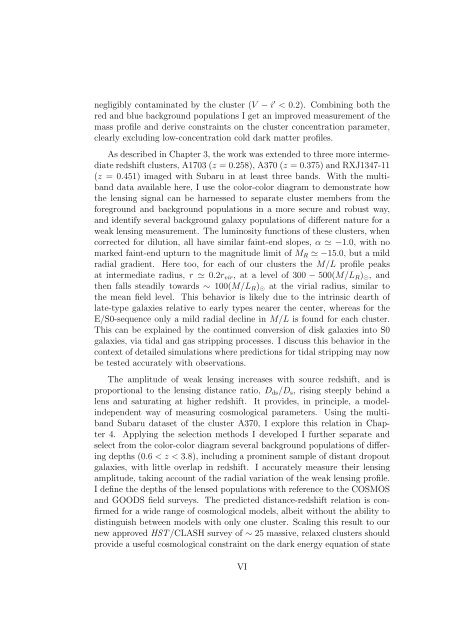Mass and Light distributions in Clusters of Galaxies - Henry A ...
Mass and Light distributions in Clusters of Galaxies - Henry A ...
Mass and Light distributions in Clusters of Galaxies - Henry A ...
You also want an ePaper? Increase the reach of your titles
YUMPU automatically turns print PDFs into web optimized ePapers that Google loves.
negligibly contam<strong>in</strong>ated by the cluster (V − i ′ < 0.2). Comb<strong>in</strong><strong>in</strong>g both the<br />
red <strong>and</strong> blue background populations I get an improved measurement <strong>of</strong> the<br />
mass pr<strong>of</strong>ile <strong>and</strong> derive constra<strong>in</strong>ts on the cluster concentration parameter,<br />
clearly exclud<strong>in</strong>g low-concentration cold dark matter pr<strong>of</strong>iles.<br />
As described <strong>in</strong> Chapter 3, the work was extended to three more <strong>in</strong>termediate<br />
redshift clusters, A1703 (z = 0.258), A370 (z = 0.375) <strong>and</strong> RXJ1347-11<br />
(z = 0.451) imaged with Subaru <strong>in</strong> at least three b<strong>and</strong>s. With the multib<strong>and</strong><br />
data available here, I use the color-color diagram to demonstrate how<br />
the lens<strong>in</strong>g signal can be harnessed to separate cluster members from the<br />
foreground <strong>and</strong> background populations <strong>in</strong> a more secure <strong>and</strong> robust way,<br />
<strong>and</strong> identify several background galaxy populations <strong>of</strong> different nature for a<br />
weak lens<strong>in</strong>g measurement. The lum<strong>in</strong>osity functions <strong>of</strong> these clusters, when<br />
corrected for dilution, all have similar fa<strong>in</strong>t-end slopes, α ≃ −1.0, with no<br />
marked fa<strong>in</strong>t-end upturn to the magnitude limit <strong>of</strong> M R ≃ −15.0, but a mild<br />
radial gradient. Here too, for each <strong>of</strong> our clusters the M/L pr<strong>of</strong>ile peaks<br />
at <strong>in</strong>termediate radius, r ≃ 0.2r vir , at a level <strong>of</strong> 300 − 500(M/L R ) ⊙ , <strong>and</strong><br />
then falls steadily towards ∼ 100(M/L R ) ⊙ at the virial radius, similar to<br />
the mean field level. This behavior is likely due to the <strong>in</strong>tr<strong>in</strong>sic dearth <strong>of</strong><br />
late-type galaxies relative to early types nearer the center, whereas for the<br />
E/S0-sequence only a mild radial decl<strong>in</strong>e <strong>in</strong> M/L is found for each cluster.<br />
This can be expla<strong>in</strong>ed by the cont<strong>in</strong>ued conversion <strong>of</strong> disk galaxies <strong>in</strong>to S0<br />
galaxies, via tidal <strong>and</strong> gas stripp<strong>in</strong>g processes. I discuss this behavior <strong>in</strong> the<br />
context <strong>of</strong> detailed simulations where predictions for tidal stripp<strong>in</strong>g may now<br />
be tested accurately with observations.<br />
The amplitude <strong>of</strong> weak lens<strong>in</strong>g <strong>in</strong>creases with source redshift, <strong>and</strong> is<br />
proportional to the lens<strong>in</strong>g distance ratio, D ds /D s , ris<strong>in</strong>g steeply beh<strong>in</strong>d a<br />
lens <strong>and</strong> saturat<strong>in</strong>g at higher redshift. It provides, <strong>in</strong> pr<strong>in</strong>ciple, a model<strong>in</strong>dependent<br />
way <strong>of</strong> measur<strong>in</strong>g cosmological parameters. Us<strong>in</strong>g the multib<strong>and</strong><br />
Subaru dataset <strong>of</strong> the cluster A370, I explore this relation <strong>in</strong> Chapter<br />
4. Apply<strong>in</strong>g the selection methods I developed I further separate <strong>and</strong><br />
select from the color-color diagram several background populations <strong>of</strong> differ<strong>in</strong>g<br />
depths (0.6 < z < 3.8), <strong>in</strong>clud<strong>in</strong>g a prom<strong>in</strong>ent sample <strong>of</strong> distant dropout<br />
galaxies, with little overlap <strong>in</strong> redshift. I accurately measure their lens<strong>in</strong>g<br />
amplitude, tak<strong>in</strong>g account <strong>of</strong> the radial variation <strong>of</strong> the weak lens<strong>in</strong>g pr<strong>of</strong>ile.<br />
I def<strong>in</strong>e the depths <strong>of</strong> the lensed populations with reference to the COSMOS<br />
<strong>and</strong> GOODS field surveys. The predicted distance-redshift relation is confirmed<br />
for a wide range <strong>of</strong> cosmological models, albeit without the ability to<br />
dist<strong>in</strong>guish between models with only one cluster. Scal<strong>in</strong>g this result to our<br />
new approved HST /CLASH survey <strong>of</strong> ∼ 25 massive, relaxed clusters should<br />
provide a useful cosmological constra<strong>in</strong>t on the dark energy equation <strong>of</strong> state<br />
VI
















